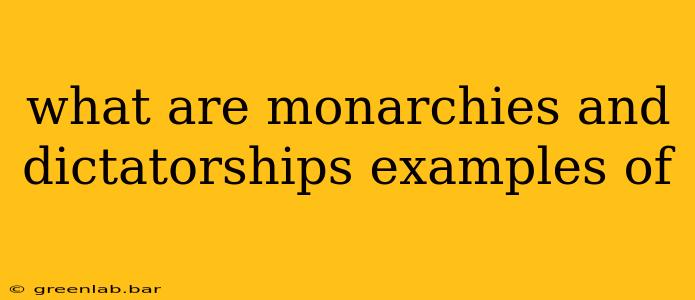Monarchies and dictatorships, while distinct, both fall under the umbrella of autocratic forms of government. They share the common thread of centralized power, lacking the democratic principles of widespread citizen participation and accountability. However, their origins, structures, and methods of succession differ significantly. Understanding these differences is key to grasping the nuances of autocratic rule.
Monarchies: Rule by Inheritance
A monarchy is a system of government where supreme power is vested in a monarch—typically a king, queen, emperor, or empress—whose position is typically inherited. This hereditary aspect is a defining characteristic. While the extent of a monarch's power can vary greatly, the fundamental principle remains: power is passed down through a lineage, often according to established succession laws.
Types of Monarchies:
-
Absolute Monarchies: The monarch holds supreme, unchecked power. Their decisions are not subject to parliamentary or other forms of limitations. Examples historically include the French monarchy before the revolution and many pre-modern empires. While truly absolute monarchies are rare today, some modern states maintain systems with significant monarchical authority.
-
Constitutional Monarchies: The monarch's power is limited by a constitution and often shared with other governmental bodies, such as a parliament. The monarch usually acts as a head of state, often with ceremonial duties, while a prime minister and parliament hold executive and legislative power. Examples include the United Kingdom, Canada, and Japan.
Examples of Monarchies (Past and Present):
- United Kingdom: A constitutional monarchy with a parliamentary system.
- Japan: A constitutional monarchy with an emperor who holds largely symbolic power.
- Saudi Arabia: An absolute monarchy, although the power structure within the ruling family is complex.
- The former Russian Empire: An absolute monarchy until its collapse in 1917.
- The French Monarchy (Ancien Régime): An absolute monarchy before the French Revolution.
Dictatorships: Rule by Force
A dictatorship is a form of government characterized by absolute rule by a single person or a small group, without effective constitutional limitations. Power is seized and maintained through force, intimidation, suppression of dissent, and often propaganda. Unlike monarchies, succession in dictatorships is not hereditary; it is usually achieved through military coups, political maneuvering, or violent seizure of power.
Characteristics of Dictatorships:
- Centralized Power: All significant power resides with the dictator or ruling clique.
- Lack of Accountability: There are no effective mechanisms for holding the leader accountable to the people.
- Suppression of Opposition: Any form of dissent is brutally suppressed, often with the use of secret police, censorship, and imprisonment.
- Control of Information: The government tightly controls access to information and media to maintain its grip on power.
- Cult of Personality: Many dictators cultivate a personality cult around themselves, using propaganda to portray themselves as essential to the state.
Examples of Dictatorships:
- North Korea: A totalitarian dictatorship under the Kim family dynasty.
- Syria (under Bashar al-Assad): A dictatorship maintaining control through military force and repression.
- Nazi Germany (under Adolf Hitler): A totalitarian dictatorship based on extreme nationalism and racist ideology.
- The Soviet Union (under Stalin): A totalitarian dictatorship characterized by communist ideology and widespread repression.
Key Differences Summarized:
| Feature | Monarchy | Dictatorship |
|---|---|---|
| Power Source | Heredity, often tradition | Force, seizure of power |
| Succession | Inherited | Not inherited, often violent or political |
| Power Limits | Can range from absolute to limited (constitutional) | Virtually no limits |
| Legitimacy | Historically, often religious or traditional; sometimes constitutional | Often none, based solely on power |
Both monarchies and dictatorships represent forms of autocratic rule, concentrating power in the hands of a few. However, understanding the differences in their origins, power structures, and succession methods provides a more nuanced understanding of these distinct, yet related, forms of governance.

